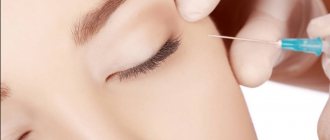- Anatomy
- Types and correction
- How to reduce
- Price
- How to hide
- Video
- Main
Large ears, or rather, large auricles, are considered an anomaly of the development of the body, in medicine called macrotia; this cosmetic defect in most cases does not affect a person’s hearing abilities in any way. Large ears disrupt the proportions of the face, and therefore their owner, as a rule, suffers from the ridicule of others since childhood , especially if macrotia is complemented by asymmetry, protruding ears (protruding ears) or deformation of the ears.
The defect is corrected using a surgical operation called otoplasty; it can be done in childhood and in the future you will not experience complexes about your own appearance, which often develop in people with large ears. Reference. When we say “ear,” we mean the pinna, which consists of cartilage tissue, intricately curved in the shape of a funnel.
In the lower part, a soft part, the lobe, is adjacent to the cartilage, and the entire “structure” is covered with skin and looks like a single whole. The outer ear protects the hearing aid, conducts and amplifies acoustic vibrations, and also identifies the source of sound. The main criterion for a large ear is its disproportion in relation to the rest of the head and body, although there are specific guidelines:
- a woman’s ear is considered large if its length is more than 77 mm and its width is more than 45 mm;
- A man's ear is considered large if its length is more than 82 mm and its width is more than 52 mm.
People with large ears do not always actually have a developmental anomaly - often the defect turns out to be visual, for example, the auricle, which has a flat shape and slightly pronounced folds, looks larger than a voluminous and prominent ear of the same size.
Types of large ears and correction techniques
The giant ear has the correct shape, that is, all areas of the auricle are increased proportionally. With this form of defect, reduction otoplasty is performed, that is, a wedge-shaped area is excised through the entire plane of the ear. It is possible to give the ear a three-dimensional shape if the surfaces of the cuts are precisely aligned and connected with seams. However, this cannot always be done, and then two more small wedge-shaped incisions are made (the result is a five-pointed figure). If the operation is performed correctly, then it leaves thin, almost invisible scars located along the edge of the ear.
In addition, people with large ears undergo surgical correction by excising strips of cartilage tissue; This operation (it is called figure-shaping surgery, it is ideal for people whose edge of the ear is flat) allows you to bend the edge of the auricle inward, so the seams are practically invisible, the integrity of the back wall is preserved, and the ear has a natural appearance.
In some cases, it is advisable to remove part of the cartilage under the helix (an incision is made from the beginning of the lobe to the highest point of the ear). This technique is good because the stitches are made under the ear fold and are impossible to see.
The described techniques allow you to uniformly reduce a large ear of normal shape, while doing it as aesthetically as possible due to the absence of noticeable scars.
The large cavity of the shell (funnel) is corrected during the operation, while the doctor removes excess cartilage tissue and, if necessary, creates a fold.
A large lobe can be either a congenital or acquired defect. In youth, a large earlobe (a lobe whose length is more than 20% of the entire length of the ear) usually does not cause any inconvenience. However, with age, there is less fatty tissue in the lobe, and the skin loses its elasticity, so the lower part of the ear sags, and signs of aging appear on it - wrinkles and creases . Surgery to reduce a lobe that is too large by nature is performed quite rarely; in most cases, plastic surgery is performed on older patients in order to rejuvenate this rather significant area in a person’s life. Let's not forget that the earlobe is an erogenous zone, and in addition, earrings are usually worn in the lower part of the ear, that is, the attention of others is deliberately drawn to the earlobe.
Another reason to turn to a plastic surgeon is the desire to get rid of the once fashionable, but with age, “tunnels” that have lost their relevance . Corrective surgery lasts no more than 20 minutes, during which the doctor removes excess tissue, forms a new lobe, and then applies stitches. By the way, large earlobes among the peoples of Africa are considered a source of pride and a standard of beauty, so they are specially pulled to monstrous sizes.
Causes of protruding ears
Doctors and scientists do not have a common opinion on this issue. It is believed that in most cases the anomaly is determined by a hereditary factor, and it appears during intrauterine development. Ear cartilage is actively formed in the fetus from 3 months, so often the child is already born with this feature.
The main reasons are:
- underdevelopment of the antihelix (hills inside the auricle);
- irregular shape of the helix (outer rim of the shell);
- macrotia (oversized shell);
- irregular structure of the ear cartilage.
The formation of cartilage ends at 6–7 years, and by this time it becomes clear to what extent the anomaly is expressed.
How to make your ears smaller
As already mentioned, the only way to really change the size and shape of your ears is through surgery. Otoplasty is performed on children from the age of six, but at this age large ears are not corrected; only malformations and deformations of the auricles are corrected. The formation of the ears ends by the age of 15, and after that it is possible to reduce the ears surgically ; For adult patients wishing to reduce large ears, there are no age restrictions.
People with large ears should first of all contact a plastic surgeon who, using computer modeling, will demonstrate what the ears will look like after surgery, performed under local anesthesia in adults and general anesthesia in children. In addition to the traditional procedure of excision of excess cartilage tissue and skin, at the patient’s request, laser otoplasty is performed - a painless and bloodless manipulation with almost no complications.
How is earlobe reduction surgery performed?
The lobe has no bones or cartilage; it consists only of skin and subcutaneous fat. When a person wears massive earrings, the tips of the ear become stretched. The changes are irreversible, they can be especially noticeable over the years, when the skin loses its elasticity, the lobes will reveal the person’s true age.
Fortunately, these aesthetic defects can be eliminated with the help of plastic surgery; earlobe reduction is a simple correction that takes a minimum of time. But since we are still talking about laser surgery, you need to trust it to an experienced and qualified surgeon who can restore the natural shape of the lobe, guaranteeing the absence of complications.
Before the operation, the surgeon will examine the problem area and determine the scope of the upcoming intervention. Depending on the nature of the problem and the individual characteristics of the patient, the doctor may choose a laser for correction. Anesthesia is selected taking into account the wishes of the clients and the state of the body.
Correction involves excision of excess skin tissue and stitching of wounds with cosmetic sutures. On the same day, the patient goes home, and after 7-10 days, when the bandage is removed, he will be able to evaluate the result of the plastic surgery - beautiful, neat, natural-shaped lobes, just as he ordered!
How much does it cost to correct large ears?
The cost of large ear reduction depends on the qualifications of the specialist, the complexity of the defect, the surgical technique used and the type of anesthesia (local or general).
| Operation | Price from |
| Cosmetic ear reduction | 22,000 rubles / 32,000 rubles. |
| Laser correction of large ears (2 ears) | 35,000 rubles. |
| Reduction of the auricle without external sutures (Kruchinsky-Kulikov technique), 1 ear/2 ears | 40,500 rubles / 55,500 rubles. |
| Plastic surgery of earlobes after tunnels | 40,000 rubles. |
| Cost of ear correctors | 1,690 rubles (corrector Arilis, for adults). |
Types of otoplasty
Otoplasty is performed using several methods. Preliminary diagnostics, a thorough study of medical indications and a detailed consultation with leading plastic surgeons will allow you to accurately determine the optimal correction option. We are ready to offer the following types of plastic surgery:
- Reconstructive. Its main goal is post-traumatic recovery and elimination of the consequences of congenital anomalies.
- Aesthetic. Allows you to correct external, visible imperfections of the auricle. Working in this direction, specialists at the Olvia Plastic Surgery Center successfully model cartilage, which makes it possible to change the shape and adjust the size.
We also perform correction and restoration of the earlobe, modeling of a new auricle (in case of its complete absence) or individual areas.
Please use our clinic's contact details if you are interested in otoplasty. The price, intervention technique and general correction scheme are developed on an individual basis. Our surgeons take into account all factors that can affect the outcome of the procedure, which allows us to achieve the desired goals in the most effective and absolutely safe ways.
How to hide big ears
Sometimes a person is sincerely mistaken, blaming his ears for all his misfortunes, because even large ears can harmoniously complement the image and there is no need to radically change their size and shape. Don't know what to do if your ears are big? Here are some tips:
Choose matching earrings. It is believed that small earrings balance out large ears, but an equally popular opinion is that “a wedge is knocked out with a wedge,” and people with large ears should wear large earrings, or even better, cuffs (original ear jewelry located along the entire plane of the auricle).
Make a bob hairstyle or wear long curls that not only hide the flaw, but also distract attention from the “protruding” part of the head. Also use all kinds of headbands and hats - these accessories will not only hide your ears, but also, if chosen correctly, will make your look stylish.
Wear glasses , even if you can see perfectly. There are accessories on sale that do not have a therapeutic effect - they can be worn without fear of damaging your eyesight. Glasses, especially those with beautiful frames that suit your face type, will draw attention to your eyes and distract from big ears. By the way, switching attention is a great idea, for which both jewelry and bright clothes are suitable.
Use decorative cosmetics . The essence of the technique is still the same - to divert attention from the ears to the face; a technique such as “face sculpting” is well suited for this: a foundation two shades darker is applied along the outer contour of the face, and the central part is covered with a foundation one or two shades lighter than natural skin color (the border is carefully shaded). At the same time, it is recommended to apply a little dark foundation to the ears.
Try using ear correctors . This advice is suitable for people with large ears that do not lie close to the head (protruding or protruding ears). The corrector is a double piece of transparent silicone that is attached simultaneously to both the ear and the scalp. If you wear such a corrector constantly, the cartilage adapts to the new position and gradually presses against the head. The method is not unambiguous, the result depends on the softness of the cartilage and the structural features of the auricle, and in addition, it requires time - we can talk about a lasting result no earlier than six months later. The most popular brands of correctors are Arilis (Russia), Mairs (Russia), Otostick (“Stop Ushastik”, Spain).
Why is protruding ears a problem?
Normally, the auricle is located at an angle of 30° in relation to the head, the distance between the ear and head is about 2 cm, and the lines of the ear and cheek are parallel. If the angle and distance are greater than normal, then the overall aesthetics of the head is disrupted. Ears appear protruding because the ear cartilage is overdeveloped or improperly attached to the head.
There are 3 degrees of protruding ears:
- I degree - mild, the angle between the ear and head is slightly higher than normal.
- II degree - quite noticeable, but not critical, the angle is on average 45o.
- III degree - very pronounced when the angle is close to 90°.
This feature is purely aesthetic in nature. You can correct it with a good hairstyle or hats. Plastic surgery for protruding ears is performed only if this anomaly causes serious psychological discomfort. Parents usually decide to correct protruding ears in children with grade III , when it is too noticeable and the child is attacked by peers.
The main thing about big ears
| Question | Answer |
| Big ears, medical name | macrotia. |
| Patient age | all age groups. |
| Nature of the defect | congenital. |
| At what age can you have surgery? | from the age of 15. |
| How to make your ears smaller | undergo surgery (otoplasty). |
| How to hide big ears | use jewelry, wear glasses, give preference to voluminous hairstyles with long hair, wear hats, use a concealer. |









